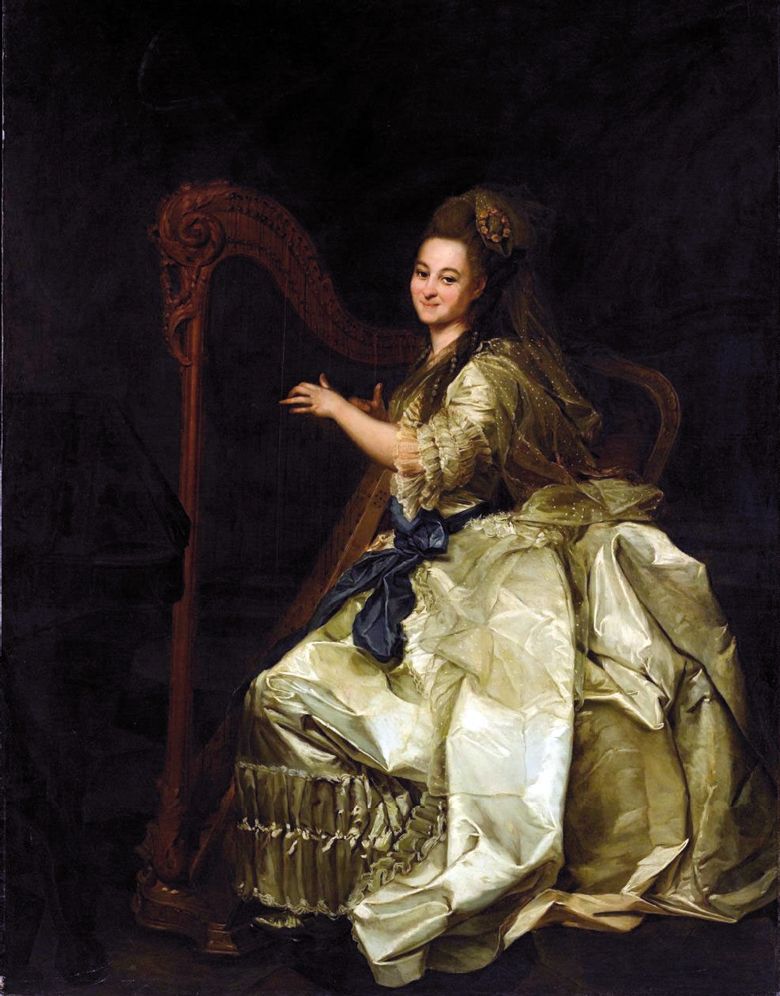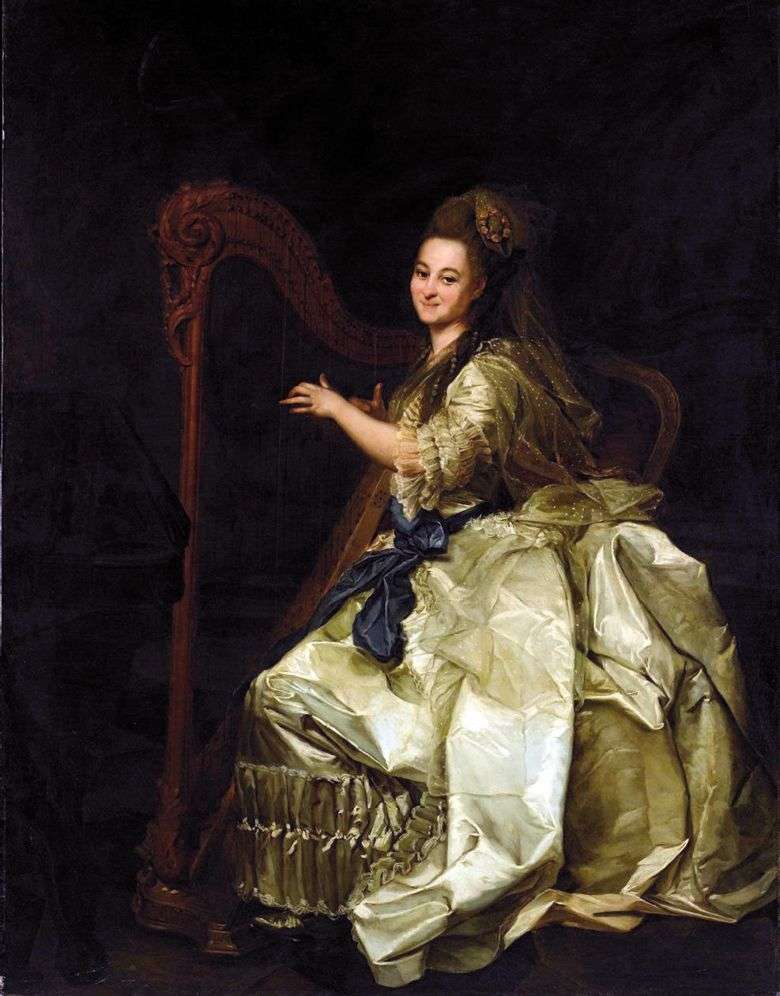
To what has already been said about the portrait of G. I. Alymova, the following can be added: as in the portrait of Levshina, the artist pays special attention to the creation of a deep-spatial composition, showing the volume of the girl’s figure.
However, in addition, Levitsky divides the space of the picture into two unequal parts, differing not only in color, but also in their “weight”: the light, transparent, with barely visible strings, the space occupied by the harp contrasts with the lighter right part of the canvas containing the figure girls The clear line of these two parts is violated only by the hands of the girl and the left knee holding the harp. It is not excluded that Levitsky intentionally “hides” Alymova’s right hand behind her left forearm, leaving only a part of the palm visible – precisely in order to preserve and make more clearly the indicated demarcating diagonal. So, without having originally a common intention of the portrait series of Smolnjanok, Levitsky nevertheless created a single suite, the content of which was the charm and beauty of youth.
Portraits are connected by the unity of formal methods, rhythm of movements, generality of compositional construction, the use of a conventional theatrical landscape background, where people dominate. In these works, the gift of Levitsky was manifested in the creation of a decorative ensemble designed for the decoration of the palace hall, and the artist’s understanding of the portrait as a large compositional picture. Levitsky was able to convincingly and sharply convey the atmosphere of some mannerism and coquetry surrounding the pupils of the Smolny Institute.
According to the successful expression of one critic, these portraits expressed “the ingeniously-sly look of a healthy and cheerful master, who in a decent way scoffed at the soul of this comedy, but at the same time appreciating its artistic charm.” But the lively realistic sense of the artist did not allow him to confine himself to the ostentatious and ceremonial side of the portrayed one; in a few cutesy game of “noble maidens” he saw the features of sincerity and immediacy.
The mannerism of his dancers sometimes gives the impression of a mock, feigned; but behind her, there is always a genuine passion for dancing girls and their genuine children’s fun. Levitsky does not flatter his characters, does not embellish their ugly faces, and even intentionally emphasizes the angular awkwardness of their movements. The realistic tendency that pervades the whole cycle of Smolenian-style, as if overcomes the conventional form of the ceremonial portrait and pushes the work of Levitsky into the series of the most advanced phenomena of Russian painting of the second half of the 18th century. And in terms of the power of artistic expression and the level of craftsmanship of the “Smolnyanka” belong to the most perfect creations of Russian and world art of that era. One of the researchers called the “Smolnyanka” “a miracle of painting”. This estimate does not seem exaggerated: “
Levitsky’s drawing is distinguished by perfect fidelity and sharp expressiveness. But especially significant are his achievements in the field of color painting and the correct transmission of gestures and movements of the girls posing for him. In a series of works Levitsky “smolnyankam” belongs to a prominent place. In these early canvases, the best aspects of the artist’s work, sharp and apt observation, striving for true vitality of images appear with obvious clarity. In later portraits, perhaps, the qualities of Levitsky the psychologist may be more clearly manifested; but by the strength of the poetic sense of Smolensk remains unsurpassed.
 Portrait de Glafira Ivanovna Alymova – Dmitry Levitsky
Portrait de Glafira Ivanovna Alymova – Dmitry Levitsky Retrato de Glafira Ivanovna Alymova – Dmitry Levitsky
Retrato de Glafira Ivanovna Alymova – Dmitry Levitsky Portrait of G. Levitsky. K (father of the artist) by Dmitry Levitsky
Portrait of G. Levitsky. K (father of the artist) by Dmitry Levitsky Portrait of the priest Peter Levitsky by Dmitry Levitsky
Portrait of the priest Peter Levitsky by Dmitry Levitsky Portrait of A. D. Levitskaya (Agashi) by Dmitry Levitsky
Portrait of A. D. Levitskaya (Agashi) by Dmitry Levitsky Portrait of N. A. Sezamov by Dmitry Levitsky
Portrait of N. A. Sezamov by Dmitry Levitsky Portrait of A. A. Vorontsova as a Child by Dmitry Levitsky
Portrait of A. A. Vorontsova as a Child by Dmitry Levitsky Portrait of A. Ya. Levitskaya by Dmitry Levitsky
Portrait of A. Ya. Levitskaya by Dmitry Levitsky